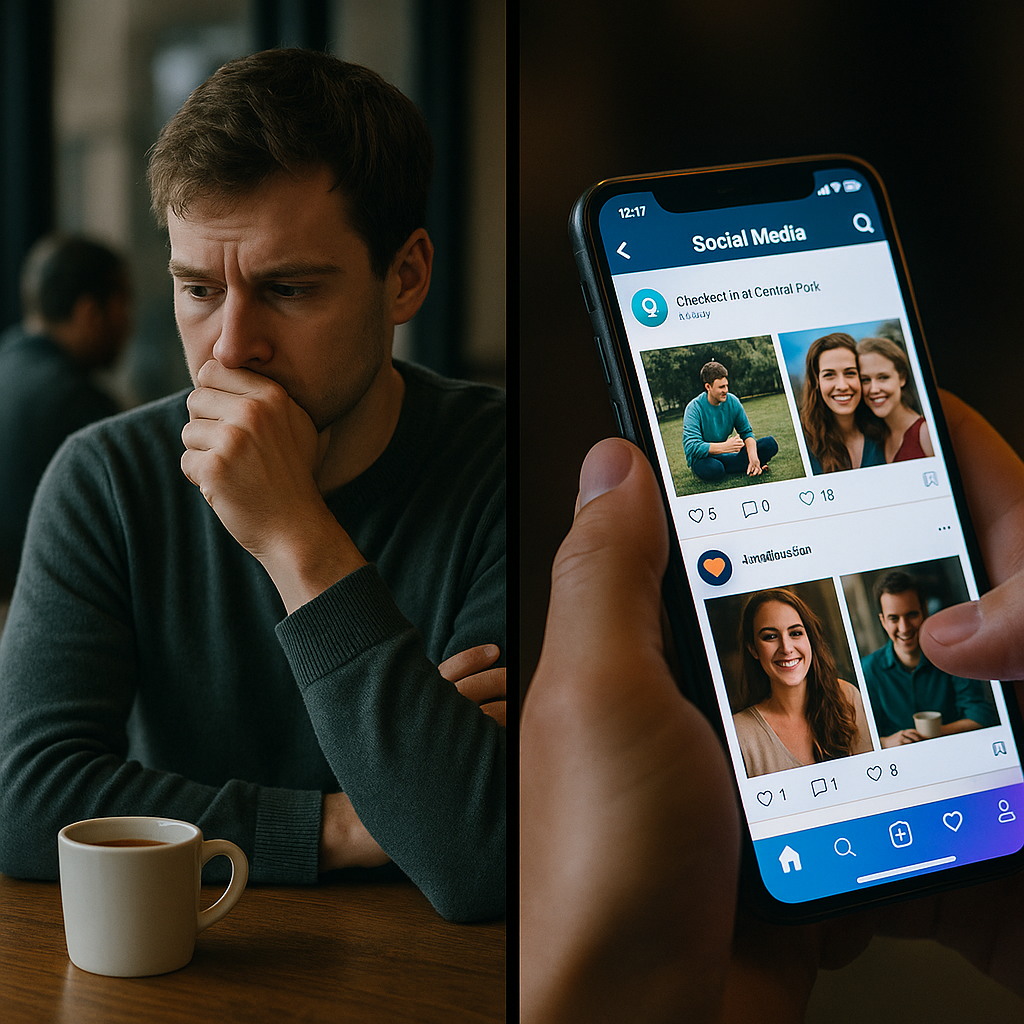Table of Contents
The Easy Offline Sharing Experiment: Observing Social Norms in Real-World Interactions
The Offline Sharing Spectrum: How Much We Actually Reveal
The Online Disinhibition Effect: Why Digital Spaces Change Everything
The Psychology Behind Virtual Identity Construction
The Dopamine-Driven Feedback Loop
Digital Identity vs Real Identity: The Growing Disconnect
The Hidden Danger: Normalization of Personal Information Sharing
What Is the Normalization of Sharing?
The Digital Identity Paradox: How Social Media Changed Personal Sharing
We behave fundamentally differently online versus offline when it comes to sharing personal information. This shift in online sharing behavior reveals a troubling trend: the normalization of oversharing with strangers in digital spaces, while maintaining strict boundaries in face-to-face interactions.
The Easy Offline Sharing Experiment: Observing Social Norms in Real-World Interactions
Before we examine digital identity vs real identity, let’s explore how we actually behave with strangers in person. Consider these everyday scenarios:
Would you say hello to, or perhaps smile at, a random stranger:
- you passed while walking in your neighborhood?
- you sat next to at the bar?
- who waved to you when you let them go ahead of you at the intersection?
- who stood next to you in the bathroom line?
- that you sat next to on the bus or train?
- at the coffee shop?
- who gives you candy?
- you sat next to on a 12-hour flight?
- [The scenarios are infinite…]
Now ask yourself: Would you share your life story with a random stranger in those same situations?
Your answers reveal your authentic self-presentation[1] in offline contexts - we tend to maintain strict social boundaries. There are unwritten social norms that dictate how strangers interact:
- Do you pretend you don’t see each other and just ignore each other?
- Do you acknowledge each other's presence by exchanging head nods?
- Do you extend pleasantries?
- Do you stop what you are doing to share your life story?
The answer is, I’m not here to give you an answer. There is no answer. My goal is to make your brain hurt.
The Offline Sharing Spectrum: How Much We Actually Reveal
My behavior in the same situations varies based on the circumstances of the encounter, but I never share my story. I’ll give my name to a stranger I’ve been sitting across from at my “office” for several hours, but only if we had talked during that time. I still don’t lead with my name. My name is mine to share when I’m ready.
Key questions about offline information sharing:
- Is the amount of information you share relative to the circumstances of the encounter?
- Is there a correlation between the amount of information shared and the duration of the encounter?
- How does this compare to our online persona vs real life behavior?
The Online Disinhibition Effect: Why Digital Spaces Change Everything
Here’s where online vs offline behavior diverges dramatically. The “online disinhibition effect”[2] - a well-documented psychological phenomenon - explains why people feel safer sharing personal information in digital spaces than face-to-face encounters.
What about sharing online with the world?
Do you share your story online where anyone can learn it because you seek attention or connection with random people that happen to comment on something you post? Do you do it to feel like you are part of a community of people that wouldn’t give you the time of day if you passed them on the street?
This represents a fundamental shift in social media self-presentation[3] - we’ve created digital identities[4] that share what our real-world selves would never reveal.
Why do we set such high barriers to sharing information with an in-person stranger, but we feel as if we must share our life story online, not with just a stranger, but THE WORLD!?
The Psychology Behind Virtual Identity Construction
Are people so hungry for approval that they begin to act according to a new online paradigm? This behavior is tied deeply to people’s sense of self-worth and represents a form of “virtual identity construction”[5] where our digital self becomes disconnected from our actual self.
People are so starved for connection that they will share their life story with the world in hopes that someone will not just like what they are saying but follow them. This online sharing behavior psychology can be traced to several factors:
The Dopamine-Driven Feedback Loop
A key distinguishing feature that separates early messaging services (like USENET and IRC) and modern social media platforms is the Like button and its corollary, the Like count. The hit of dopamine you receive when something you post is Liked creates a reward response system that has been studied and maximized to encourage increasingly personal sharing.[5]
People become trained to post content that attracts more views and likes - even content that isn’t real. This represents a fundamental shift in authentic self-expression[6], where the curated vs authentic online presence becomes increasingly disconnected from reality.
Digital Identity vs Real Identity: The Growing Disconnect
This phenomenon reveals a critical aspect of modern digital identity vs real identity. While our offline selves maintain healthy skepticism about sharing personal information, our online personas have been conditioned to overshare through algorithmic manipulation.
People will stretch their personal boundaries to tell stories that fit into the idealized world carefully crafted on social media platforms. As people conform to algorithms built to maximize eyes on screen, they begin to correlate the likes received as popularity votes.
The Hidden Danger: Normalization of Personal Information Sharing
Most research on social media focuses on mental health impacts. However, there’s a consequence that looms much larger: the normalization of sharing personal information with strangers.
What Is the Normalization of Sharing?
When requests for information become commonplace and sharing with strangers becomes a habit, people become desensitized to requests for personal information. Their personal “BS radar” doesn’t trigger alerts when requests are suspicious because nothing appears suspicious anymore.
This represents a dangerous evolution in social media authenticity - we’ve lost the ability to distinguish between appropriate and inappropriate information requests.
The Everyday Reality of Information Desensitization
I and everyone else - including you - have become desensitized to sharing personal information. You do it every day online:
- Creating accounts with companies (minimum: name and email address)
- Providing mailing addresses and credit card information for “quicker checkout”
- Some companies even request national identification numbers or driver’s license information
We provide our personal information so frequently that sharing it has become normalized behavior.
The Real-World Consequences of Digital Oversharing
What could possibly go wrong when you don’t question a stranger’s request for personal information? The consequences include:
- Social engineering attacks[7] that exploit our conditioned sharing behavior
- Identity fraud using information freely shared across platforms
- Blackmail and extortion using personal details from social media
- Privacy erosion that affects both our digital and real-world security
The normalization of sharing personal information is happening to everyone, all the time, every day. Understanding the psychological differences between our online vs offline behavior is the first step toward digital self-awareness.
Orehek, E., & Human, L. J. (2017). Self-Expression on Social Media. *Personality and Social Psychology Bulletin*, 43(1), 60-70. https://doi.org/10.1177/0146167216675332
Suler, J. (2004). The Online Disinhibition Effect. *CyberPsychology & Behavior*, 7(3), 321-326. https://doi.org/10.1089/1094931041291295
Syrjämäki, A. H., et al. (2024). Online disinhibition mediates the relationship between emotion regulation difficulties and uncivil communication. *Scientific Reports*, 14, 24932. https://doi.org/10.1038/s41598-024-81086-7
Digital Identity - Wikipedia. https://en.wikipedia.org/wiki/Digital_identity
Binter, J., et al. (2024). Digital Being: social media and the predictive mind. *Neuroscience of Consciousness*, 2024(1), niae008. https://doi.org/10.1093/nc/niae008
Bailey, E. R., Matz, S. C., Youyou, W., & Iyengar, S. S. (2020). Authentic self-expression on social media is associated with greater subjective well-being. *Nature Communications*, 11, 4889. https://doi.org/10.1038/s41467-020-18539-w
Meier, A., et al. (2021). Social Media Use and Adolescents' Self-Esteem: Heading for a Person-Specific Media Effects Paradigm. *Journal of Communication*, 71(1), 56-78. https://doi.org/10.1093/joc/jqaa039
Found in:
Privacy and Security
